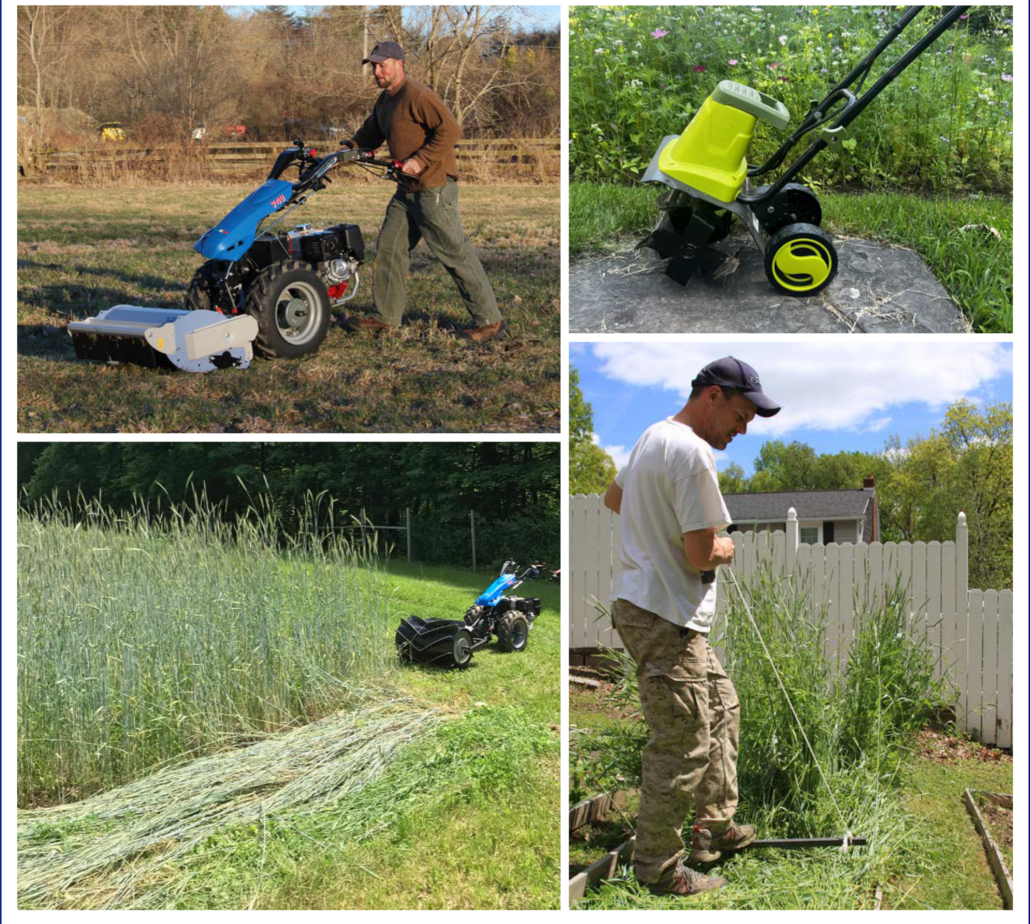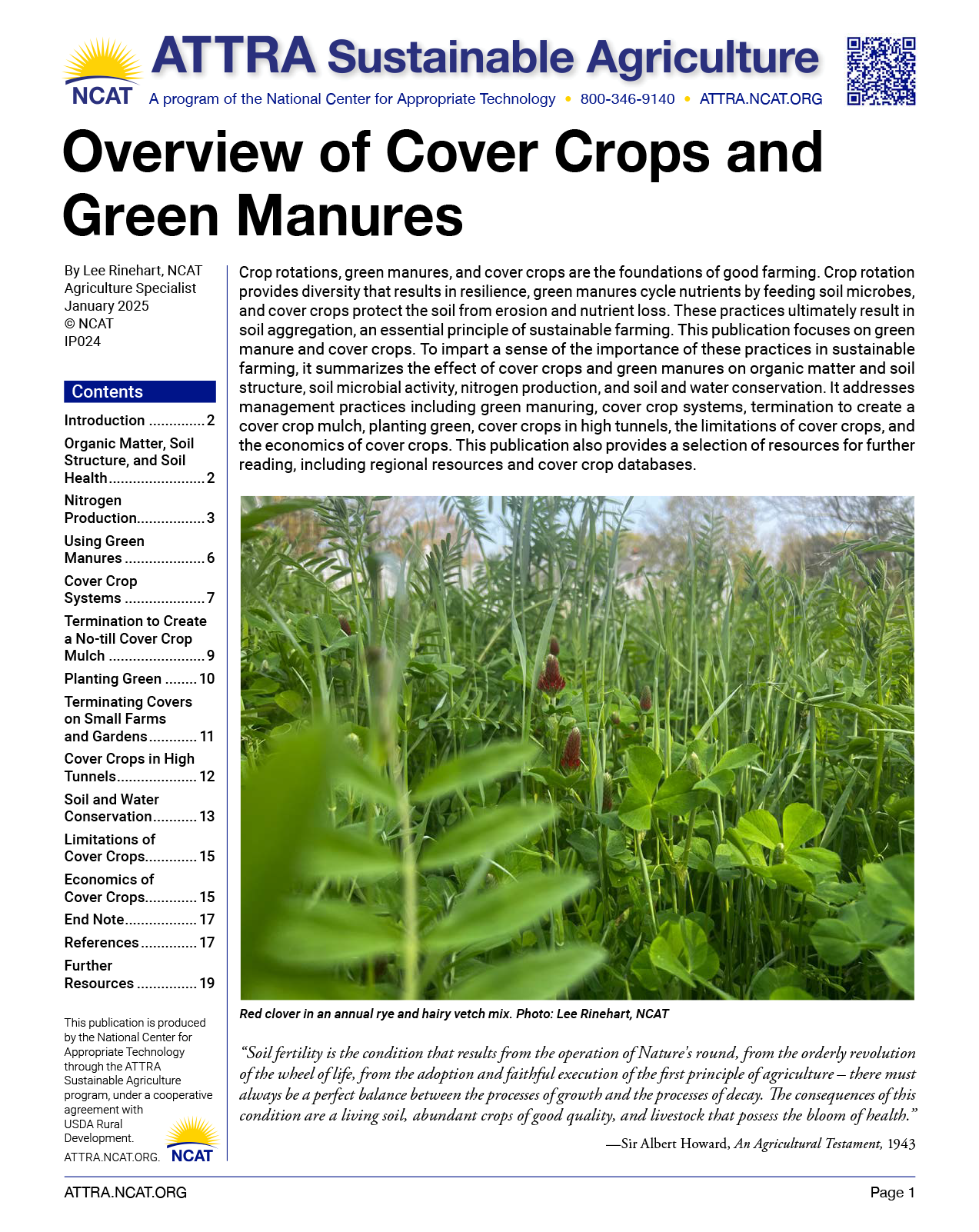Overview of Cover Crops and Green Manures
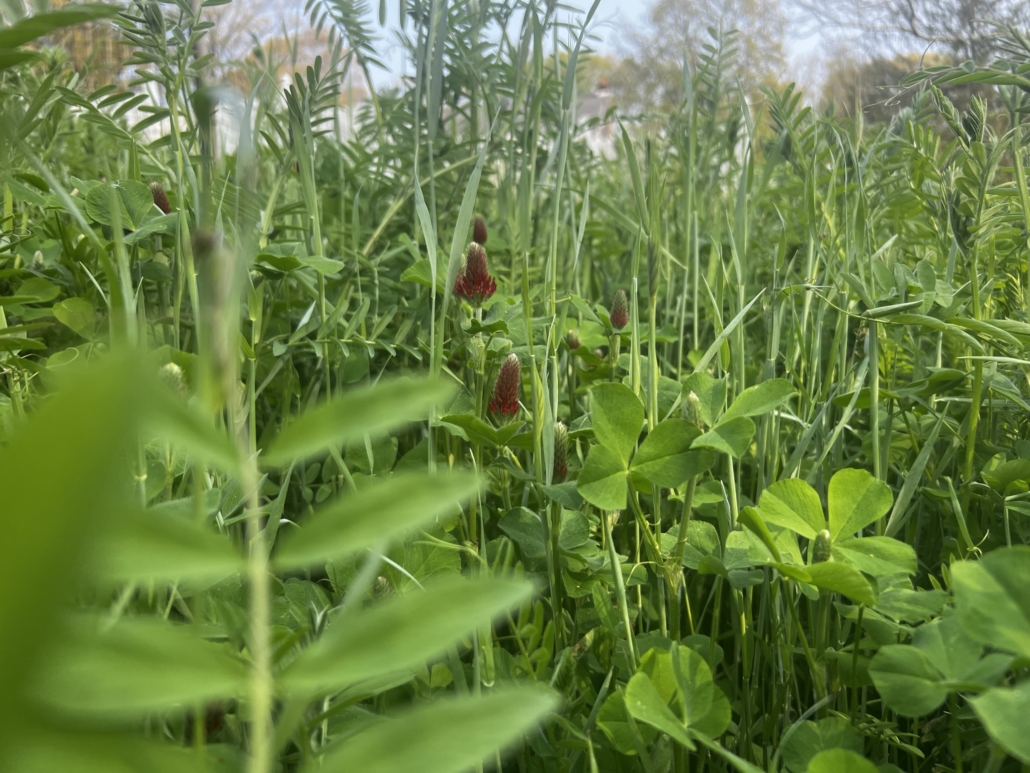
Red clover in an annual rye and hairy vetch mix. Photo: Lee Rinehart, NCAT
By Lee Rinehart, NCAT Agriculture Specialist
Abstract
Crop rotations, green manures, and cover crops are the foundations of good farming. Crop rotation provides diversity that results in resilience, green manures cycle nutrients by feeding soil microbes, and cover crops protect the soil from erosion and nutrient loss. These practices ultimately result in soil aggregation, an essential principle of sustainable farming. This publication focuses on green manure and cover crops. To impart a sense of the importance of these practices in sustainable farming, it summarizes the effect of cover crops and green manures on organic matter and soil structure, soil microbial activity, nitrogen production, and soil and water conservation. It addresses management practices including green manuring, cover crop systems, termination to create a cover crop mulch, planting green, cover crops in high tunnels, the limitations of cover crops, and the economics of cover crops. This publication also provides a selection of resources for further reading, including regional resources and cover crop databases.
“Soil fertility is the condition that results from the operation of Nature’s round, from the orderly revolution of the wheel of life, from the adoption and faithful execution of the first principle of agriculture – there must always be a perfect balance between the processes of growth and the processes of decay. The consequences of this condition are a living soil, abundant crops of good quality, and livestock that possess the bloom of health.”
—Sir Albert Howard, An Agricultural Testament, 1943
Contents
Introduction
Organic Matter, Soil Structure, and Soil Health
Nitrogen Production
Using Green Manures
Cover Crop Systems
Termination to Create a No-till Cover Crop Mulch
Terminating Covers on Small Farms and Gardens
Planting Green
Cover Crops in High Tunnels
Soil and Water Conservation
Limitations of Cover Crops
Economics of Cover Crops
End Note
References
Further Resources
Introduction
“We don’t solve for individual problems; we solve for a pattern… the whole.” – Paul Muller (organic farmer and executive board member of The Real Organic Project), EcoFarm Conference, 2023
Cover crops are an integral part of a farm ecosystem. This is nothing new. By around 300 BC, the Greeks and Romans were planting legumes for their advantages to soil fertility. Native Americans developed the Three Sisters concept of planting corn, beans, and squash together for the synergistic benefits of diversity while providing food to entire communities. Early North American colonists used buckwheat, oats, and rye to add organic matter to the soil, and, later, in the Southeast, growers relied on green manure crops for soil fertility (Warman, 1980). Then, beginning around the 1940s, the United States saw a notable decline in the use of green manures, due to imports of guano (a nitrogen source) from South America and, later, with the advent of Green Revolution technology and the Haber-Bosch process that made possible the manufacture of nitrate fertilizer.
Cover crops are any non-cash crop grown in addition to the primary cash crop to keep the soil covered for as much of the year as possible and to “increase soil organic matter and fertility, reduce erosion, improve soil structure, promote water infiltration, and limit pest and disease outbreaks” (UC SAREP, 2020). They may also be used as an additional income source when seed is harvested and sold for various uses, or they can be grazed by livestock to augment or extend the grazing season. However, one of the most beneficial uses of cover crops is to reduce the use of on-farm inputs. Cover crops can greatly help farmers grow their own fertility and significantly reduce or eliminate nitrogen fertilizer.
Green manuring involves mowing, crimping, and/or tilling of any field or forage crop, including cover crops, while they are green or soon after flowering. Using green manure as a source of fertility can greatly reduce the need for nitrogen fertilizer (Liebman et al., 2011). In many cases, as in diversified vegetable production, green manuring can eliminate synthetic nitrogen applications entirely. High-biomass legume green manures, grown prior to a vegetable crop, return as much as 100 to 200 pounds per acre of nitrogen to the soil, potentially offsetting the need for nitrogen application requirements altogether (Grubinger, no date b).
Common Cover Crop Species
- Grasses – Cereal rye, triticale, wheat, barley, millet, oat, annual ryegrass, sorghum-sudangrass
- Broadleaves – Flax, sunflower, buckwheat, safflower, phacelia, chicory
- Brassicas – Radish, turnip, kale, canola, mustard, camelina
- Legumes – Field peas, soybeans, cowpeas, hairy vetch, clover, medic, sweetclover, sunn hemp, alfalfa
Organic Matter, Soil Structure, and Soil Health
A major benefit from cover crops and green manures is the addition of organic matter to the soil. Compounds such as gums, waxes, and resins are formed during the breakdown of organic matter by microorganisms, while glomalin is produced by mycorrhizal fungi to help bind soil particles together as granules, or aggregates. A well-aggregated soil is also well-aerated and has a high water-infiltration rate. Increased levels of organic matter also influence soil humus. Humus—the end product of the decay of plant and animal residues in the soil—provides a wide range of benefits to crop production.
The contribution of organic matter to the soil from a green manure crop is comparable to the addition of nine to 13 tons per acre of farmyard manure or 1.8 to 2.2 tons dry matter per acre. (It is important to consider that green manure doesn’t have the equivalent amounts of P and K of farmyard manure.) Approximately 2.2 tons per acre, per year of crop residue are considered adequate to maintain soil organic matter at constant levels in continuously cropped soils (Schmid and Klay, 1984).
Cover crops provide the biomass (carbon) and the diversity needed for soil microorganism populations to thrive. Muhammad et al. (2021) sifted through data from 81 studies on the effect of cover crops on soil microorganism abundance and structure and found that soil total bacteria and total fungi increased by 7% to 31% when cover crops were used, compared to systems with no cover crop. A greater fungi-to-bacteria ratio suggested that fungi were more positively affected by cover crop treatment than were bacteria (Muhammad et al., 2021).
Also, a field study in Nebraska compared the effects of a field pea cover crop and a no-till summer fallow on microbial populations in spring and fall wheat crops. The researchers used Solvita tests to determine soil microbial activity, expressed as the release of carbon dioxide from microbial metabolism. Results of the two-year study showed higher soil microbial activity, greater microbial species diversity, and greater nitrogen release in the cover cropped fields, compared to the fallow (Stepanović, 2017).
Soil Microorganisms and Carbon-to-Nitrogen Ratio
A rapid increase in soil microorganism activity occurs after a lush green manure crop is incorporated into the soil, as soil microbes multiply to decompose the fresh plant material. During microbial breakdown, nutrients held within the plant tissues are released and made available to the following crop.
Factors that influence the ability of microorganisms to break down organic matter include soil temperature, soil moisture, and the carbon-to-nitrogen (C:N) ratio of the plant material, as well as how well the soil was previously managed. The optimum C:N ratio for rapid decomposition of organic matter is between 15:1 and 24:1. C:N ratios above 24:1 can result in nitrogen being “tied up” by soil microbes in the breakdown of carbon-rich crop residues, thus pulling nitrogen away from crop plants. The C:N ratio reflects the kind and age of the plants from which the green manure was derived. As plants mature, their fibrous (carbon) material increases and protein (nitrogen) content decreases. Consequently, lush green manures are richer in nitrogen relative to carbon, especially in comparison to highly lignified crop residues like corn stalks. It will take a lot longer for soil microbes to break down corn stalks than fresh hairy vetch. Many farmers plant a mix of annual rye or cereal rye and clover or vetch in the fall for late spring or summer green manure. The legume provides nitrogen, and the high biomass of the rye provides a more balanced diet for the soil microorganisms, while the nitrogen in the legume aids in decomposition of the rye.
| Table 1. C:N Ratio of Selected Organic Materials | |
| Organic Material | Carbon: Nitrogen Ratio |
| Hairy vetch/alfalfa | 10:1 to 15:1 |
| Rye (seedlings) | 12:1 to 15:1 |
| Sweet clover | 14:1 to 16:1 |
| Food waste | 14:1 to 16:1 |
| Grass clippings | 18:1 to 20:1 |
| Rye (flowering) | 20:1 to 21:1 |
| Fruit waste | 38:1 to 36:1 |
| Dry leaves | 50:1 to 56:1 |
| Corn stalks | 58:1 to 60:1 |
| Straw | 60:1 to 72:1 |
| Sawdust | 250:1 to 500:1 |
| Source: Girma et al., 2017 | |
The C:N ratio is more a function of the plant’s nitrogen content than its carbon content. Most plant materials contain close to 40% carbon. To determine the C:N ratio of any plant material, divide 40% by its nitrogen content. For example, the C:N ratio of hairy vetch with 4.2% nitrogen content is figured like this: 40/4.2=9.5. The procedure for determining the nitrogen content of cover crop biomass is explained below, in the section “Nitrogen Production.” Estimating the nitrogen contribution of a cover crop is very helpful when adjusting nitrogen fertilizer rates to account for legume nitrogen.
Nitrogen Production
Nitrogen production from legumes is a key benefit of growing cover crops and green manures. Leguminous cover crops can accumulate from 40 to 200 pounds of nitrogen per acre. The amount of this nitrogen available for a subsequent crop depends on the species of legume grown, the total biomass produced, and the percentage of nitrogen in the plant tissue. Cultural and environmental conditions that limit legume growth—such as delayed planting date, poor stand establishment, and drought—can all reduce the amount of nitrogen produced. On the other hand, conditions that encourage good nitrogen production include inoculation of legume seed with the right culture, getting a good stand, optimum soil nutrient levels and soil pH, good nodulation, and adequate soil moisture.
The portion of green-manure nitrogen available to the following crop is usually about 50% of the total amount contained in the legume (Cover Crop Strategies, 2020). For example, a hairy vetch crop that accumulated 180 pounds of N per acre prior to crimping or plowing down will contribute approximately 90 pounds of N per acre to the succeeding grain or vegetable crop. Nitrogen is more quickly made available to subsequent crops when the cover crop is tilled in as green manure than when it is left on the surface as mulch.
| Table 2. Nitrogen Contribution from Cover Crops | |
| Cover Crop | Nitrogen (pounds per acre – total plant) |
| Berseem clover | 75-220 |
| Cowpeas | 100-150 |
| Crimson clover | 70-130 |
| Field peas | 90-150 |
| Hairy vetch | 90-200 |
| Medic | 50-120 |
| Mustards | 30-120 |
| Radish | 50-200 |
| Red clover | 50-120 |
| Sweetclover | 90-170 |
| White clover | 80-220 |
| Source: SARE, 2007 | |
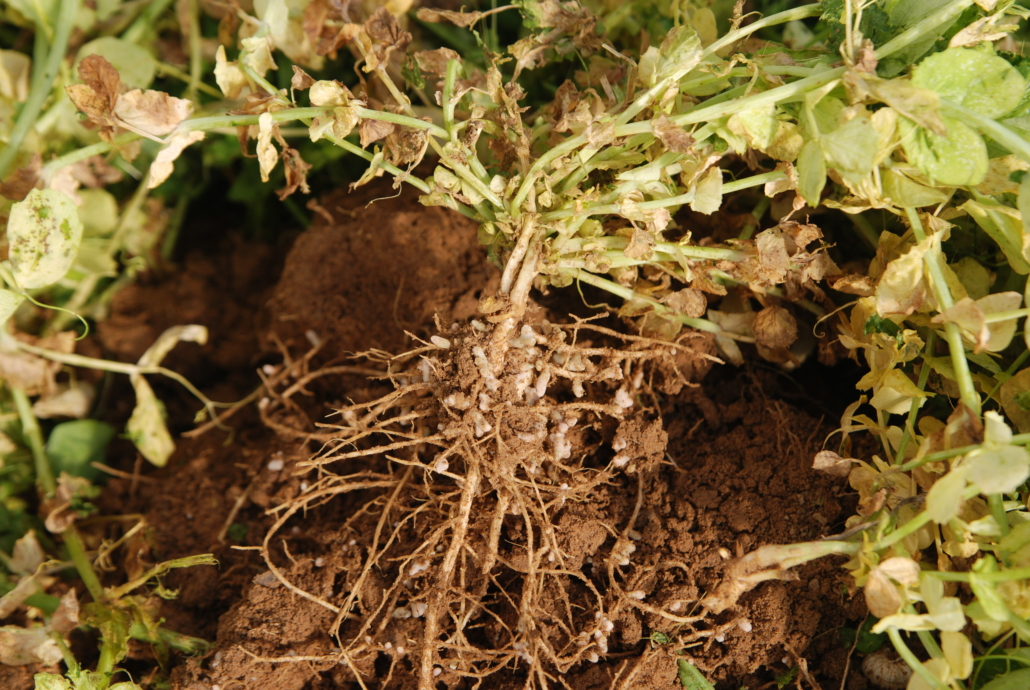
Legume nodulation. Photos: Rex Dufour, NCAT
Three steps to ensure optimum nitrogen carryover to cash crops from legumes:
Assuming adequate water, soil fertility, and soil pH, the following practices will heighten the chances of getting good nitrogen carryover from legume cover crops:
- Inoculate the seed with the proper bacterial inoculant prior to planting. Use Rhizobium leguminosarum bv. Viceae for peas and vetch; Rhizobium leguminosarum bv. Trifolii for red clover, crimson clover, and white clover; Rhizobium spp. (cowpea) for cowpeas, peanut, and sun hemp; and Sinorhizobium meliloti for alfalfa (NRCS Plant Materials Program, 2021).
- Terminate the cover crop at bud or early flower stage for optimum nitrogen contribution, as nitrogen in the leaves decreases rapidly after flowering and starts to accumulate in seeds (Cover Crop Strategies, 2020).
- Maintain good management practices, including adequate water, fertility, and soil pH.
Source: SARE, 2007
How Much Nitrogen Is in My Cover Crop?
To determine how much nitrogen is contained in a cover crop, you need an estimate of the yield of above-ground herbage and its nitrogen content. A procedure to make this determination is available on page 22 of SARE’s Managing Cover Crops Profitably. The procedure involves taking a field sample, drying it, weighing it, and calculating the dry matter yield per acre. Then, the sample can be sent off for forage analysis, which includes an estimate of protein content. Once you know the protein content, simply divide it by 6.25 to obtain the percentage of nitrogen contained in the cover crop tissue. Finally, to obtain pounds of legume nitrogen per acre, multiply the percent nitrogen by pounds of biomass per acre.
Growing Fertility at Three Springs Farm
Emily Oakley and Michael Appel co-own and operate Three Springs Farm, a diversified, certified-organic vegetable farm in eastern Oklahoma. They cultivate more than 40 different crops and more than 150 individual varieties on their small farm. Their goal is to maintain an operation that demonstrates the economic viability of small-scale farming while minimizing the use of external fertility inputs.
Emily Oakley and Michael Appel, Three Springs Farm, Oaks, Oklahoma. Photo: Jay Fram, www.jayfram.com
When Emily and Michael started, they needed to transform their worn-out soils into something alive and immediately planted a pea cover crop. Back then, they used chicken manure from CAFOs to add fertility, but they “wanted no part in being a dumping ground” for industrial waste. With that, chicken manure was out. Now, they grow about 90% of their fertility right on the farm with a diversified crop rotation and cover cropping sequence.
Three Spring Farm is laid out with three acres of vegetable crops and another three acres in cover at all times. Of the four fields on the farm, two are in cash crops and two are in fallow cover all year. A common field rotation on the farm starts with a spring cash crop, followed by a summer cover crop. A fall/winter cover follows summer, with the whole next year in fallow covers. The next summer, the field will go into a summer cash crop, followed by a winter cover, both a summer cover and winter cover the next year, then a different spring crop will start the rotation again.
Hear Emily explain her crop rotation and fertilizer reduction in a session from ATTRA’s 2023 Growing Hope Conference. Also, listen to Emily’s story “Growing Fertility on the Farm” on the Real Organic Project’s podcast. Finally, visit Mike and Emily’s farm at threespringsfarm.com.
Using Green Manures
Green manures can be cut and left on the soil surface as a mulch or incorporated into the soil by tillage. If left as a mulch, the green manure will help with weed suppression and water conservation, but decomposition will be slower, as will the nutrient release to the cash crop. To incorporate or not depends on the goals the grower has for the cover crop.
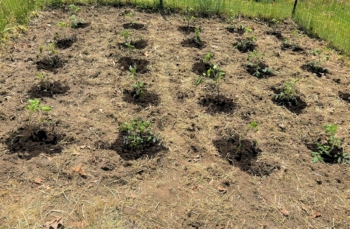
Tomatoes planted into a tilled-in rye, vetch, and red clover green manure, May 21. Photo: Lee Rinehart, NCAT
Incorporating cover crops provides a faster release of nutrients but does not provide weed suppression. With mowing and tillage, you get better contact between organic matter and the microbes that will feed on it. Tilling in cover crops also tends to allow soil to warm faster in the late spring, but the tillage also releases carbon dioxide into the air.
Timing is critical for incorporating cover crops into the soil. Soil moisture and temperature are important for soil microbes to wake up and begin the decomposition process. Soil moisture should be at field capacity, meaning 60% of the pore space in the soil is filled with water. Field capacity is generally reached in about a day after a soaking rain (SARE, 2007). Soil pH should be between 6 and 8, and the soil temperature should be warm, above 60°F. Finally, aeration is needed to provide oxygen to microbes and ensure aerobic decomposition.
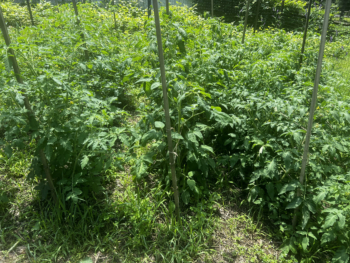
Tomato crop 50 days after transplanting, July 10. Photo: Lee
Rinehart, NCAT
Renowned growers Anne and Eric Nordell incorporate green manure into the top two inches of the soil instead of burying it deeply. They have found that shallow tilling of cover crops and compost “promotes aerobic decomposition, simplifies weed management, and improves tilth and moisture retention” (Nordell and Nordell, 2018). They have also seen their cash crops get off to a faster start, because the nutrients released through microbial decomposition are placed near the plant roots, where plants can better make use of them.
Good incorporation of a green manure into the soil at the proper time should provide for optimum nitrogen release. For a legume or a grass cover crop (or mix), a rule of thumb is to turn the cover crop under when it is at about mid-bloom. At this stage, the bacteria population decomposing the organic matter will explode and can double within a week (SARE, 2007). For monoculture legumes, expect a large release of nitrogen, some of which may be lost through volatilization or denitrification. High-carbon organic matter, such as mature grasses, straw, etc., will tie up nitrogen, as the bacteria use it to break down the fibrous material. The delay of nutrient availability to crops can last several weeks. But, when a legume is combined with a small grain, the added carbon of the grass will slow down nitrogen release from the legume and make the system more manageable, better timing the availability of nitrogen being released with the demand of the newly planted cash crop.
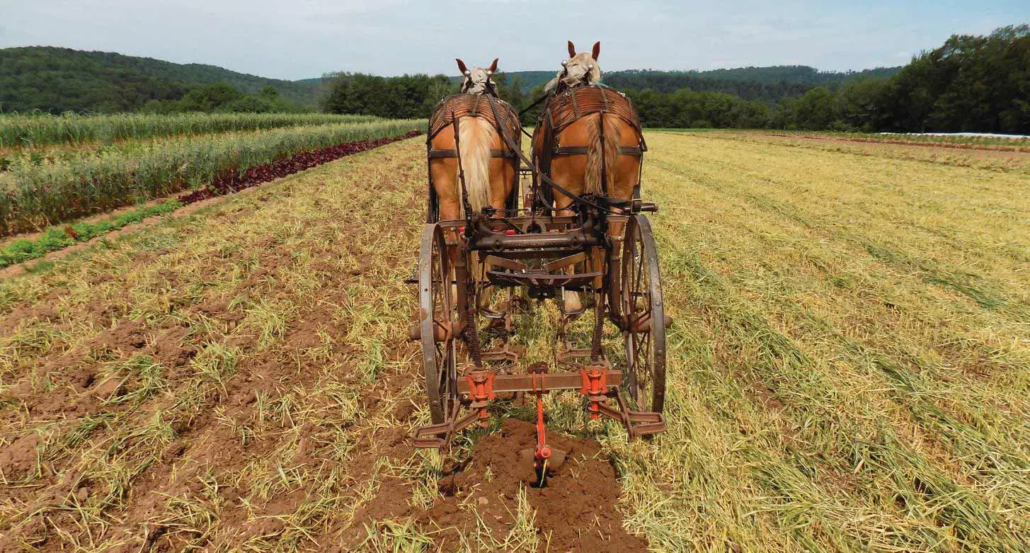
Undercutting barley cover crop after mowing. Photo: Eric Nordell
As stated earlier, the optimal C:N ratio in the soil for biological activity is about 24:1. When the ratio gets above 24:1, the bacteria will begin consuming extra nitrogen in the soil to digest the extra carbon, effectively tying up nitrogen for several weeks. When the appropriate cover crop mix is planted, soil moisture and temperature are adequate, and the cover crop is tilled into only the first few inches of soil, the stage is set for providing fertility on-site. Then, it’s just a matter of timing for incorporation. Wait at least a week to plant into a plowed-in legume green manure, one to two weeks for a legume-grass mix, and up to three weeks before planting into a high-carbon green manure. These recommendations are variable, as soil moisture and temperature play a role in microbial decomposition. If a cover crop is incorporated when nighttime temperatures in the spring are in the 40s, for instance, decomposition will slow down. In this situation, the interval between termination and cash crop planting should be increased.
In addition to incorporation by mowing, followed by rototilling or discing, cover crops can also be undercut with a cultivator fitted with sweeps to cut the roots just below the soil surface and then covered over with a furrower. This is a method the Nordells have used for incorporation, followed by a spring-tooth harrow. For market garden beds, a flail mower followed by a rototiller is very effective. Walk-behind tractors can be efficient for small farms, and rototiller and flail mower attachments are available for them. For more detail on tools and equipment for small farms, see the ATTRA publication Equipment and Tools for Small-Scale Intensive Crop Production.
Cover Crop Systems
Cover crops can fit well into many different cropping systems during periods of the year when no cash crop is being grown, or they can be interseeded into cash crops (as discussed below). Even the simplest corn/soybean rotation can accommodate a rye cover crop following corn, to scavenge residual nitrogen and provide ground cover in the fall and winter. When spring-killed as a no-till mulch, the rye provides a water-conserving barrier and suppresses early-season weeds for the following soybean crop. Hairy vetch can be planted behind soybeans to provide nitrogen for corn the following spring. However, hairy vetch is not a good cover crop to use when small grains are included in the rotation: if the vetch ever goes to seed, it can become a terrible weed in the small-grain crop. In these cases, crimson clover, sweet clover, or red clover are better choices, depending on location.
Many vegetable rotations can accommodate cover crops, as well. For example, buckwheat can follow lettuce and still be tilled down in time for fall broccoli. Hairy vetch works well with tomatoes and other warm-season vegetables. The vetch can be killed by flail mowing and tomato sets planted into the mulch. Managing Cover Crops Profitably has a nice section on crop rotation with cover crops, starting on page 34.
Vern Grubinger, Vegetable and Berry Specialist with the University of Vermont, notes four strategies for incorporating cover crops into a crop rotation. These are fallow, winter cover crops, smother crops, and interseeding (Grubinger, no date a). In addition, summer cover crops, catch crops, and forage crops can fit into the rotation.
Winter cover crops are sown in late summer or autumn and remain in place until spring to provide soil cover during the winter (Grubinger, No date a). Growers often choose a legume cover for the added benefit of nitrogen fixation. In northern states, the plant selected needs to possess enough cold tolerance to survive hard winters. Hairy vetch, crimson clover, annual rye, and, in southerly regions of the North, Austrian winter peas are among the options that meet this need. Winter cover crops can be established by aerial seeding into maturing cash crops in the fall, as well as by drilling or broadcasting seed immediately following harvest.
Smother crops are cover crops grown in any season between cash crops, usually for weed suppression (Grubinger, no date a). Weeds flourish on bare soil, but cover crops take up space and light, thereby shading the soil and reducing the opportunity for weeds to establish themselves. The soil-loosening effect of deep-rooting covers also reduces weed populations that thrive in compacted soils. Field peas are known for their weed-control benefits because of their high biomass productivity.
Interseeding (or intercropping) is when cover crops are planted into a cash crop and can remain in place for varying amounts of time (Grubinger, no date a). Interseeded covers provide a living mulch to suppress weeds by competing with them for light, moisture, and nutrients. They help reduce soil erosion, enhance soil fertility, and improve water infiltration. Examples of living mulches in annual cropping systems include overseeding hairy vetch into corn at the last cultivation, no-till planting vegetables into subterranean clover, drilling sweet clover into small grains, interseeding Dutch white clover into vegetables in the summer, and broadcasting annual ryegrass into vegetables. In fact, interseeding into a cash crop is useful on smaller-scale farms when all available land is in production, but a cover crop still needs to get planted, especially in the fall for overwintering or winter-kill cover crops (Pressman, 2023). Interplanted living mulches in perennial cropping systems are simply the grasses or legumes planted in the alleyways between rows in orchards, vineyards, Christmas trees, berries, windbreaks, and field nursery trees to control erosion, provide traction, and offer habitat for beneficial insects and pollinators. The SARE publication Crop Rotation on Organic Farms: A Planning Manual is an excellent source of information on rotations and includes a chapter on intercropping beginning on page 95. It contains a handy chart depicting various intercropping systems.
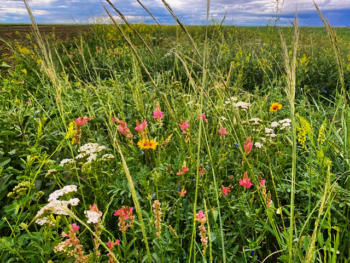
Wildflower planting in buffer strip to provide habitat for pollinators. Photo: Vilicus Farms
Summer cover crops occupy the land for a portion of the summer growing season. These warm-season cover crops can be used to fill a niche in crop rotations, to improve the conditions of poor soils, or to prepare land for a perennial crop. Legumes such as cowpeas, soybeans, annual sweet clover, sesbania, guar, crotalaria, or velvet beans may be grown as summer green manure crops to add nitrogen and organic matter. Non-legumes, such as sorghum-sudangrass, millet, forage sorghum, or buckwheat, are grown to provide biomass, smother weeds, and improve soil tilth. Buckwheat is a fast-growing summer crop that works well as a soil cover between summer and fall crops and provides excellent habitat for pollinators.
For hot, humid areas, choose a diverse mix of species such as peanut, pigeon pea, partridge pea, centrosema, butterfly pea, sunn hemp, desmodium, lablab, velvet bean, scarlet runner bean, stylosanthes, and mung bean. For more on planting cover crops in humid and sub-tropical regions, see the ATTRA publication Cover Crop Options for Hot and Humid Areas.
A catch crop is a cover crop established after harvesting the main crop and is used primarily to reduce nutrient leaching from the soil. For example, planting cereal rye following corn harvest helps to scavenge residual nitrogen, thus reducing the possibility of groundwater contamination. Annual ryegrass, as opposed to cereal rye, is good at scavenging phosphorus. In these instances, the catch crops also function as winter cover crops. Short-term cover crops that fill a niche within a crop rotation are also commonly known as catch crops.
Finally, forage crops in rotation with cash crops function both as cover crops—when they occupy land for pasturage or haying—and as green manures—when they are eventually incorporated or terminated for a no-till planting. They may consist of grass-legume sods like fescue-clover, bermudagrass-white clover and orchardgrass-red clover pastures, or a diverse annual pasture for summer grazing that may be incorporated and planted to fall crops later in the year. For maximum soil-improving benefits, the forage should not be grazed or cut for hay during its last growth period to allow time for above and below-ground biomass to accumulate prior to terminating.
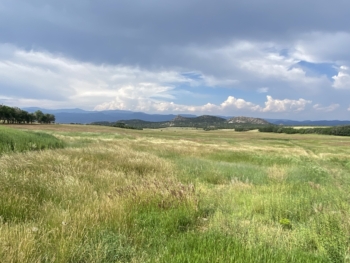
Perennial sod in crop rotations helps replenish organic matter in the soil. Photo: NCAT
The “exceptional initial ‘sod-crop’ yields following cultivation of the prairies during westward expansion is a testimony to the value of sod-based cropping systems” (Gates, 2003). Because of this, forages are often placed in the crop rotation for their soil-building characteristics. Grassland soils naturally accumulate organic matter through the extensive root systems of perennial plants, and the development of a dense root system may also lead to improved soil aggregate stability (Zani et al., 2021). However, soils under continuous cropping have about 50% of the organic matter of soils under perennial grassland vegetation (NRCS, 2004). Zani et al. (2021) concluded in a study that a grass-clover ley period length (or time in a perennial grass-clover cover) equivalent to 30% to 40% of the crop rotation sequence (i.e., three to four years in a 10-year period) is needed to increase aggregate stability and soil carbon concentration.
Termination to Create a No-till Cover Crop Mulch
Herbicides are the most commonly used tools for cover crop suppression in no-till systems. However, chemical herbicides can cause ecological disruptions to soil organisms, including damage to earthworms; inhibition of nitrogen fixation, mineralization, and nitrification; and site-specific increases in disease (Rose et al., 2016). In addition, conventional herbicides are not allowed in organic production, so those are off the table for farmers who are certified organic.
Mowing is an effective termination method for some cover crops, but timing is critical. For example, mowing a rye cover crop when it heads out in late spring provides sufficient kill. The rye must be in the pollination phase, or later, to be successfully killed. When the anthers are fully extended and you can thump the stalk and pollen falls, it is time to mow. If mowed earlier, the rye will regrow. Flail mowers generally produce more uniformly distributed mulch than do rotary cutters, which tend to windrow the mulch to one side of the mower. Sickle-bar mowers create uniform mulch, but the unchopped rye stalks can be more difficult to plant into. If late-spring weather continues cool and wet, more rye regrowth will occur than if the weather remains warm and drier. Typically, if rye is mowed at the pollination stage, regrowth is minimal and not a problem to crops grown in the mowed mulch.
Flail mowing or rolling with rolling disk colters are usually equally effective in killing hairy vetch. Timing is a key factor when using these methods to terminate cover crops. Termination of legumes is most effective when the plant growth stage of the cover crop is at about 50% bloom.
Rolling and crimping is a method of cover crop termination that is gaining ground. To create a roller-crimper, a drum has blades welded to the surface to form a V-shaped chevron pattern around it. The drum can be filled with water to adjust the weight of the implement. The roller-crimper rides on a structure that can be placed in front of or behind a tractor, and, as the drum passes over the cover crop, it lays down, and the chevron-shaped blades crimp the stems of the plants as the roller-crimper passes over them. When this is done at the correct stage of plant maturity, an effective kill can be accomplished. What is left is a mulch that can be planted into immediately after termination, or, with an appropriate rig, planting can occur as the cover crop is crimped, during the same tractor pass.
A Few Notes on Roller-Crimping
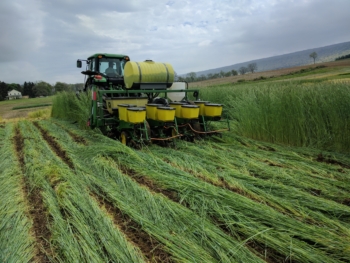
Rolling and crimping annual rye and planting soybeans in one pass. Photo: Heidi Reed,
Penn State University
Successful termination of cover crops using a roller-crimper can be better assured by paying attention to a few key principles of crop physiology and weather conditions. Timing is important for mowing a cover crop, but it is even more important if the cover crop is going to be rolled and crimped. For the best results, the cover crop must be crimped when it is reaching maturity. If it is crimped too early, the cover crop will stand up and continue growing. For most crops, the best time to crimp is when the plants are flowering. For small grains, like rye, this is simple, as the plants in the field will reach flowering at about the same time. For legumes it’s a little trickier, as the field tends to flower in stages. Most farmers crimp legumes when more than one-half the field is in flower. For small grain/legume mixes, termination should occur according to the stage of the legume.
For the best results, cover crop termination using mechanical means like roller-crimping should be done in hot, dry weather conditions. Anguelov et al. (2020) describe some key management practices and suggestions to ensure a good cover crop kill and subsequent cash crop success. These include the following:
- Planting cover crops early to allow for optimal growth stage prior to termination by rolling/crimping
- Allowing cereal grains to grow tall before termination, to prevent regrowth
- Crimping when the soil is firm, to prevent the cover crop from being pushed into the soil
- Terminating cover crops at least three weeks before planting crops to prevent competition
- Rolling and crimping in a direction parallel to the cash crop rows to allow easier planting with a no-till planter and minimize residue buildup on the planter
Finally, planting cover crops that are known to readily winterkill is another non-chemical means of vegetation management. Spring oats, buckwheat, sorghum, and—in northern regions—winter peas fill this need. These should be fall-planted early enough to accumulate some top growth before freezing temperatures kill them. In some locations, oats will not be completely killed, and some plants will regrow in the spring. Winter-killed cover crops provide a dead mulch through the winter months, instead of green cover. They are used primarily in regions where precipitation is limited and in situations where farmers want to plant early in the spring.
Terminating Covers on Small Farms and Gardens
Terminating cover crops can be accomplished on any scale, though the technology (and practices) needed for larger fields can be more complicated and expensive (see “A Few Notes on Roller-Crimping”). Market gardeners are accustomed to walk-behind tractors. These versatile machines are appropriate for farms up to an acre in size, and various implements are available for them, from flail mowers to tillers to crimpers. Most small-scale farmers and gardeners use a flail mower and tiller to terminate and incorporate cover crops. Flail mower attachments are composed of a rotating drum inside a cowling, with flails or spades attached to the drum. Flail mowers can handle more biomass than a rotary mower and do not throw debris, which is why many farmers choose them to mow cover crops. The cover crop residue can be left on the surface as mulch or tilled in with a disc or rototiller. Roller-crimping, however, is an option for cover crop termination even on small plots. With careful attention to timing to ensure the cover crop is mature, a market gardener can effectively roll and crimp a cover crop (see the accompanying photos) and plant large-seeded crops or transplants directly into the mulch.
Top left: Walk-behind tractor with flail mower attachment. Photo: Andy Pressman, NCAT. Bottom left: Walk-behind tractor with roller-crimper attachment. Photo: Andy Pressman, NCAT. Top right: Electric tiller for small-scale gardens and market farms. The author effectively used this tiller to incorporate a high biomass rye, vetch, and clover cover crop to a depth of six inches after mowing. Photo: Lee Rinehart, NCAT. Bottom right: Crimping annual rye in a garden bed, using a length of steel angle with a rope as a handle. Photo: Andy Pressman, NCAT
Planting Green
No-till and cover crops are all the rage, and many farmers are adopting these practices because of their soil health benefits and reductions in fertilizer use. But in some areas of the country, like the Northeast, cover crops can have a cooling effect on the soil and can delay planting of summer cash crops (Reed et al., 2022). Cool, wet soils are also great habitat for slugs, and many no-till cover croppers in the Northeast are looking for management strategies to tackle this crop pest. One method of promise to deal with cool, wet soils is planting green.
Planting green is when summer crops are planted directly into the cover crop before it is terminated. Soils that have a living cover crop tend to be a bit dryer, and this can be a benefit in wet springs, making cash crop planting more feasible. However, planting green may not be the best practice when soils are too dry in the spring, due to the cover crop’s added drying effect.
Planting green provides the benefit of allowing the cover crop to gain more biomass and maturity before termination, since many cover crops—like annual rye—do not grow much during winter but take off significantly in the spring. Depending on how late spring comes each year, there may not be enough time to get the biomass you need from the cover crop (Rees and Proctor, 2020). Planting green can allow for an optimum planting time while still maintaining some of the benefits of the cover crop.
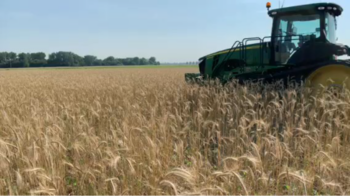
Soybeans are no-till planted into cereal rye at boot stage, then rolled/crimped at v2. Photo: Rick Clark
Termination of the cover crop for no-till farmers who plant green is usually accomplished by herbicide application around 15 days after planting the cash crop (Rees and Proctor, 2020). However, crimping is becoming more popular with many commercial grain producers, especially organic no-till farmers. Rick Clark operates a six-crop-rotation operation on 1,200 certified-organic acres in Warren County, Indiana, where he has a practice of sowing corn and soybeans into live-standing cover crops of rye and clover and then crimping the cover crop/green manure after planting (Coggins, 2023). He terminates the cover crop with a roller-crimper up to 30 days after planting, but typically within three to five days. The late planting allows Rick to let the cover crop reach a better maturity before crimping and achieve higher cover crop biomass and subsequent nutrient carryover. This system provides fertility and weed control for summer cash crops, meaning Rick applies no starter fertilizer, fungicide, seed treatment, or insecticide. Because of his regenerative organic practices, he has also eliminated phosphorus, potassium, and nitrogen fertilization and has reduced diesel use by 48% (Clark, 2021). Any yield reductions are completely offset by a substantive decrease in input costs, resulting in a net positive income.
Cover Crops in High Tunnels
Soil salinity levels are known to rise faster and to a higher degree under high tunnels than they do in the field. In a 2022 article in ACRES USA, Anne and Eric Nordell, diversified vegetable farmers in Pennsylvania, describe that, in field conditions, rain helps leach nutrients and salts deeper into the soil. Not so in a high tunnel, where nutrients and salts tend to accumulate. “At a high enough concentration,” they write, “these soluble salts can make it difficult for plant roots to take up moisture, a condition called ‘chemical induced drought’” (Nordell and Nordell, 2022). This situation can result in poor germination, stunted plants, and lowered yields.
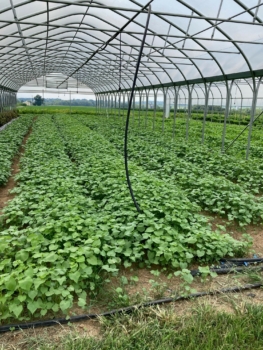
Buckwheat cover crop in a high tunnel following an early
summer cash crop. Photo: Chris Lent, NCAT
The Nordells mitigate this problem by pulling the plastic off the high tunnels periodically and letting rain leach the salts deeper into the soil profile. “Six inches of [low salt] irrigation water are usually sufficient to leach 50% of the soluble salts out of the top foot of soil. To remove 90% of the salts, 24 inches of water may be necessary” (Nordell and Nordell, 2022). They remove the plastic in the winter, as well, and put the high tunnels in different locations in the field periodically. Within this rotation are two years of vegetables in high tunnels, followed by two years of high tunnel cover crops.
Another approach is to plant cover crops that accumulate salts as they grow and remove them from the high tunnel, rather than incorporating them into the soil. Jennifer Taylor and Ron Gilmore of Lola’s Farm in Georgia experimented with this idea in 2017. They planted barley and hairy vetch in their high tunnel, for nitrogen from the vetch and for barley’s ability to take up salts (Southern SARE, 2018). Barley has high salt tolerance and can handle saline soils of up to 8 dS/m (measured by electrical conductivity) without yield loss, whereas most fruits and vegetables can handle salinities only up to 1 to 2 dS/m (Zamora Re et al., 2022). Barley, alfalfa, and spring wheat have high salt uptake efficiencies and, depending on weather and soil conditions, have potential to phytoremediate salt-affected soil (Shah et al., 2022).
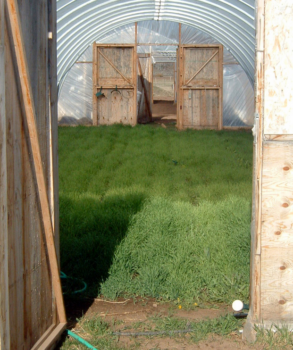
Small grain cover crop growing in a high tunnel. Photo: Evergreen Farm
Finally, another strategy that the Nordells use to manage nutrients is limiting the use of compost on soils that test high in nutrients, especially phosphorus and potassium. Amendments like compost and manure are usually applied to meet the nitrogen needs of the crop, though the use of dairy-manure-based compost can exacerbate salinity problems in soils. And, with all manures, over-application of phosphorus can occur. The Nordells recommend, in this instance, meeting the nitrogen needs of crops with amendments like blood meal or feather meal (Nordell and Nordell, 2022). For more on phosphorus management, see the “Nutrient Enhancement” section above.
Soil and Water Conservation
When cover crops are planted for soil and water conservation, they should provide a high percentage of ground coverage as quickly as possible. Most grassy and non-legume cover crops, like buckwheat and rye, fulfill this need well. Of the winter legumes, hairy vetch provides the least autumn ground cover because it puts on most of its above-ground growth in the spring. Consequently, it offers little ground cover during the erosion-prone fall and winter. Sowing a mix of legume and grassy-type cover crops will increase the ground coverage, as well as provide some nitrogen to the following crop. Another approach used by many organic farmers is higher-than-normal cover crop seeding rates, which will provide ground cover more quickly and reduce weed competition.
The soil conservation benefits provided by a cover crop extend beyond protection of bare soil during non-crop periods. The mulch that results from a terminated cover crop in no-till plantings increases water infiltration, reduces water evaporation from the soil surface, and reduces extreme soil temperatures, which is beneficial to soil microbes. Additionally, soil cover reduces soil crusting and subsequent surface-water runoff during rainy periods.
Cover Crops in High-rainfall Events
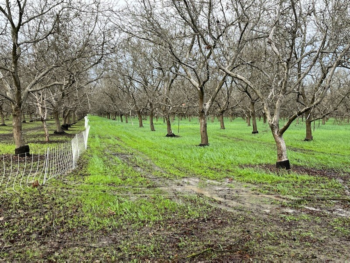
Cover-cropped California orchard after heavy rains, January 15, 2023.
Photo: Rex Dufour, NCAT
In January 2023, central California received more than 10 inches of rain over the course of several weeks. After many years of drought, this might have seemed like a benefit to farmers. But, as of the 2017 census, only 4% of California’s farmland acres were in cover crops (Zulauf and Brown, 2019). The rain that could have been such an advantage became, for many farmers, another crisis. Almond orchards near Woodland, California, became very soggy from all the rain, but those with cover crops had little or no standing water after the rain event. Some of those orchards were already grazing their cover crop with sheep. Soils in the cover-cropped orchards became a sponge and infiltrated water, even from unprecedented storms. Conversely, non-cover-cropped orchards couldn’t infiltrate the several inches of standing water after the rains. Many trees were flooded for more than a month, which can be devastating for an almond farmer, particularly during February and March when trees are in the process of blooming and leafing out. Some of the orchards with poor soil management even lost trees due to rotted roots, when subsequent high winds simply tipped the trees over (Dufour, 2023).
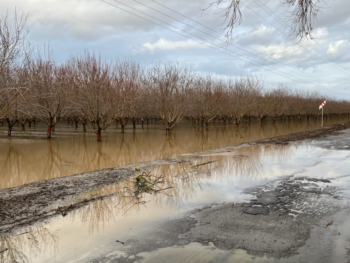
Non-cover-cropped California orchard after heavy rains, January 15, 2023. Photo: Rex Dufour, NCAT
The contrasting almond orchards had the same relative soil type but different management. If ever there is empirical evidence of the efficacy of keeping soil covered with living roots, this is it. Cover crops, by helping soil particles clump together into aggregates, greatly impact the soil’s ability to infiltrate water and allow it to become adsorbed to soil particles. Conversely, poorly aggregated soils have reduced water-holding capacity and more compaction and surface crusting, resulting in greatly reduced water infiltration and subsequent runoff and erosion. Living and dead roots from cover crops or resident vegetation in the soil provide channels for water to infiltrate into the root zone and, ultimately, into the water table. The implementation of the Sustainable Groundwater Management Act (SGMA) in California, the source of nearly all the almonds (2 million acres), walnuts and pistachios (500,000 acres each) in the country, will require water conservation practices beyond what most growers are presently doing.
Cover Crops in Low-Rainfall Areas
In 2017, researchers initiated a three-year study in south Texas to investigate the effects of soil moisture on cash crop yield following cover crops (Kasper et al., 2022). During the study period, farmers and researchers planted five replicates of five cover crop treatments. Each treatment was composed of four cover crop plots and a control plot, in which no cover crops were planted.
The average annual precipitation of the study area is 20 inches. During the research trials, just 3.5 inches of rain fell between cover crop planting in the fall and sorghum harvest in the summer during year one. During year two, 14.1 inches were recorded, and 11.4 inches fell during the same time period in year three.
Cover crops lose water through evapotranspiration, so moisture deficits at cash crop planting can be expected if rainfall is low. In this study, the plots in cover crops had soil moisture deficits compared to the control plots in all three years. Sorghum crop losses occurred in years one and three. Year two had the highest rainfall of all years in the study, resulting in a successful sorghum harvest, though yields from cover cropped plots and control plots showed no statistically significant difference (Kasper et al., 2022).
The high biomass produced by the cover crops was associated with crop losses in years one and three, due to lowered soil moisture. “More [cover crop] biomass means more evapotranspiration, lower soil moisture, and an increased risk of cash crop germination failure” (Kasper et al., 2022). Farmers may be able to manage biomass amounts by reducing cover crop seeding rates to the lowest recommended level. Using lower-biomass covers like vetch or clover and lowering the seeding rates may reduce the chances of the cover crop impacting soil moisture, while still providing some benefit to soil health (Kasper et al., 2022). In semi-arid zones, or in years when rainfall is reduced, lowering cover crop biomass is a tradeoff between the soil health benefits accrued from cover crops and having the possibility of a viable cash crop with a sustainable yield.
Another consideration for reducing soil water loss is tillage. The farmer in the study referenced here used tillage to terminate the cover crop, which may have enhanced soil moisture loss. A no-till method of termination, whether chemical or mechanical (roller-crimping), might have saved soil water by keeping the soil covered with residue. However, it’s important to understand that the decision to use tillage is nuanced. Doug Crabtree, an organic small-grain and pulse farmer in dryland northern Montana, has found that tilling crop residues into the soil aids in decomposition, since the very dry conditions in the region do not facilitate decay fast enough if residue is left on the surface (Coggins, 2023).
In summary, the Kasper study suggests that decisions about type of cover crop, seeding rate, termination method, and length of time between cover crop termination and cash crop planting (to allow for the possibility of rainfall prior to planting) may all affect soil moisture loss and yield reductions in cash crops in semi-arid zones (Kasper et al., 2022). There is also the question of farmer knowledge and experience with cover crops, as well as the type of cover crop termination employed. In this study, the farmer flail-mowed the cover crop and then disked the residue into the soil. If this study had used the residue as mulch and no-till planted the sorghum, might additional soil moisture have been conserved? Again, there is nuance in making cover cropping decisions. Tillage does lead to moisture loss, so a change in termination practices—in this case, perhaps, no-till planting into a cover crop mulch—might have had a positive impact on cash crop yield.
NCAT Sustainable Agriculture Specialist Colin Mitchell and Dr. Alexis Racelis (research collaborator on the above project) discuss cover crop water use in semi-arid environments in ATTRA’s Voices from the Field podcast, episodes 222 and 223.
Limitations of Cover Crops
The recognized benefits of green manuring and cover cropping—soil cover, improved soil structure, nitrogen from legumes—need to be evaluated in terms of cash returns to the farm, as well as the long-term value of sustained soil health. For the immediate growing season, seed and establishment costs need to be weighed against reduced nitrogen fertilizer requirements and the cover crop’s effect on cash crop yields.
Water consumption by green manure crops is a significant concern in areas with limited precipitation. Still, even in the fallow regions of the Great Plains and Pacific Northwest, several native and adapted legumes (such as black medic) seem to have potential for replacing either cultivation or herbicides in summer fallow. There is always additional management required when cover crops of any sort are added to a rotation. Turning green manures under requires additional time and expense, compared to having no cover crop at all.
Insect communities associated with cover crops work to the farmer’s advantage in some crops and create a disadvantage in others. For example, some living mulches enhance the biological control of insect pests of summer vegetable crops and pecan orchards by providing favorable habitats for beneficial insects. On the negative side, winter legumes that harbor catfacing insects, such as the tarnished plant bug, stink bug, and plum curculio, can pose problems for apple or peach orchardists in the eastern U.S. Nematodes encouraged by certain legumes on sandy soils are another concern of farmers, as are cutworms and wireworms (click beetle larvae) in rotations following grain or grass crops. And, slugs can be a serious issue for no-till farmers in the mid-Atlantic and Midwest.
During cool, wet springs, mulch covers provide good slug habitat and, since slugs need a high-protein diet, germinating crop seeds are a target (Garrabrant and Cochran, 2023). Some practices that may help reduce slug damage to cash crops include planting green and terminating covers later, or planting cash crop seeds deeper so they germinate a little later, when slug populations are smaller.
Economics of Cover Crops
Economists define profit as the difference between revenue from the sale of goods or services and the costs to produce those goods or services (Schahczenski, 2023). There are two ways to make a profit: charging a good price for your product or cutting your costs. Unless you are a savvy marketer with an established market, charging more for your product is unlikely, especially in commodity markets. Many experienced farmers, economists, and farm advisors suggest that one of the best ways to maintain farm profitability is to reduce your input costs. Cover cropping can help do this, but that comes with a caveat. If you have never planted a cover crop, there will be a learning curve. If you have soils with low organic matter, it will take time to move the needle upwards. Farmers who have incorporated cover crops into their rotations and have allowed time for their soils to adjust to the new regime for many years are usually more profitable than farmers who have just started cover cropping (Soil Health Partnership, no date). And, several farmers report that using cover crops has made farming fun again (Dufour, 2023).
The most obvious direct economic benefit derived from legume cover crops is nitrogen fertilizer savings (though savings are also possible from reducing or eliminating herbicide and insecticide use). In most cases, these savings can offset cover crop establishment costs. Indirect benefits include herbicide reduction (in the case of an allelopathic rye cover crop), reduction in insect and nematode control costs, protection of groundwater by scavenging residual nitrate, and water conservation derived from a no-till mulch and increased rainwater infiltration into the water table. Longer-term benefits are derived from the buildup of organic matter, resulting in increased soil health. Healthy soils cycle nutrients better, do not erode as much, quickly absorb water after each rain, and produce healthy crops and bountiful yields.
The costs associated with annual cover crops may include tillage, seed, planting, irrigation, and termination. For example, hairy vetch and crimson clover seed typically cost around $5 per pound. With a 15-pound-per-acre seeding rate, seed costs are about $75 per acre. With a 20-pound seeding rate at $5 per pound and a $27 per acre no-till drilling cost, it would cost $127 to plant an acre of this cover crop. Furthermore, organic seed can cost about twice as much as conventional seed.
Many studies have shown that legume cover crops can replace a portion of the fertilizer nitrogen requirements for a following crop. (See the “Nitrogen Production” section above.) The economic value of these nitrogen replacements can be calculated by using a local nitrogen price. These costs can then be compared to cover crop seed and planting costs. Remember, nitrogen cost comparisons alone do not consider the benefits of improved soil health and increased water infiltration that result from cover crops.
It is certainly possible to be profitable while using cover crops. A meta study by Louisiana State University determined that, for soybean cash cropping, cover cropping had a significant positive effect on yield and economic return. The review of cover crop studies revealed that soybeans without a cover crop yielded 48.3 bushels per acre with a return of $91.70 per acre, while the cover-cropped soybeans yielded 50.9 bushels per acre with a return of $112.20 per acre (Adusumilli and Wang, 2020).
It is also possible to find studies that show the opposite result. From 2017 to 2019, scientists conducted a study in Mississippi on cover crop profitability in corn-soybean production (Badon et al., 2021). In this study, cover cropping did not lead to higher yields or reduce irrigation water use, resulting in negative economic benefits. The scientists reported an economic loss of $233 per hectare on average overall site years for their study.
What is behind the disparities in these two studies? There are differences between the soils, the management, and the goals of the farmers in each study. There are differences between how long the two farms under consideration have been using cover crops in their rotations. When comparing a farm that is profitable using cover crops with one that is not, there are likely some big differences in management. For example, there may be differences in the diversity of crop rotations. The cover crop species or mixes used may not be the same, because the management goals are different. Also, there are variations based on whether a farmer uses conventional tillage, minimum tillage, or no-till. Furthermore, think about whether the cover crop is monetized by selling seed or grazing biomass or residue, how and when the cover crop is terminated, the types of irrigation practices, the difference in labor and the number of tractor passes between conventional and cover cropping systems, as well as hay requirement reductions from grazing cover crops. All these practices contribute to whether a farm is profitable or not, and if careful attention isn’t paid to how they interact with each other, an economic loss may result.
End Note
Cover crops have received much attention in the past several years due to their ability to buffer soil temperatures, conserve water, and lower fertilizer bills. But, as farmers know only too well, cover crops are not a silver bullet that can solve all our agronomic problems. They should be used appropriately and in combination with crop rotations, reduced use of pesticides and synthetic fertilizers, and, if possible, livestock grazing. Finally, an economic analysis is a crucial part of a farmer’s decision-making toolbox.
One of Vandana Shiva’s principles of good farming is the law of return. Cover cropping is an ancient practice, prescient in our days, that exemplifies this principle. And, as Wendell Berry wrote in his 1997 book, The Unsettling of America: Culture and Agriculture, “The soil is the great connector of lives, the source and destination of all. It is the healer and restorer and resurrector, by which disease passes into health, age into youth, death into life. Without proper care for it we can have no community, because without proper care for it we can have no life.”

Planting cereal rye cover crops in the garden beds of an urban farm outside of the Department of Agriculture Whitten Building in Washington, D.C. Photo: USDA
References
Adusumilli, Naveen and Hua Wang. 2020. Cover Crop Economics: Analysis from Studies Across Louisiana. LSU Ag Center.
Anguelov, Gueorgui, et al. 2020. Conservation Tillage Systems in the Southeast. Jason Bergtold and Marty Sailus, editors. Sustainable Agriculture Research and Education.
Badon, T.B., J.M. Czarnecki, L.J. Krutz, J.M, Shockley, and B.H. Baker. 2021. Cover crop and minimum tillage effect on yield, irrigation water use, and net returns. Agrosystems, Geosciences, and Environment.
Clark, Rick. 2021. Growing Healthy Soils on a Large Scale. Soil Health Innovations Conference. National Center for Appropriate Technology.
Coggins, Andrew, NCAT Rocky Mountain West Regional Director. 2023. Personal communication.
Cover Crop Strategies. 2020. Lower C:N Ratios, Termination Determine Nitrogen from Covers. Lessiter Media.
Dufour, Rex, NCAT Senior Fellow. 2023. Personal communication.
Garrabrant, Paige and Rachel Cochran. 2023. Controlling Slugs and Voles in Cover Crops. Ohio State University Extension.
Gates, Roger N. 2003. Integration of Perennial Forages and Grazing in Sod Based Crop Rotations. In: Proceedings of Sod Based Cropping Systems Conference, North Florida Research and Education Center-Quincy, University of Florida.
Girma, Kefyalew, Hailin Zhang, and Warren Roberts. 2017. Building Soil Organic Matter for a Sustainable Organic Crop Production. Oklahoma State University Extension.
Grubinger, Vern. No date a. Cover Crops and Green Manures. University of Vermont.
Grubinger, Vern. No date b. Sources of Nitrogen for Organic Farms. University of Vermont Extension.
Howard, Albert. 1943. An Agricultural Testament. Oxford University Press, Oxford, United Kingdom.
Kasper, S., F. Mohsin, L. Richards, and A. Racelis. 2022. Cover crops may exacerbate moisture limitations on South Texas dryland farms. Journal of Soil and Water Conservation Vol. 77, No. 3. p. 261-269.
Liebman, Matt, Rhonda L. Graef, Daniel Nettleton, and Cynthia A. Cambardella. 2011. Use of legume green manures as nitrogen sources for corn production. Renewable Agriculture and Food Systems. Vol. 27, No. 3. p. 180–191.
Muhammad, Ihsan, Jun Wang, Upendra M. Sainju, Shaohong Zhang, Fazhu Zhao, and Ahmad Khan. 2021. Cover cropping enhances soil microbial biomass and affects microbial community structure: A meta-analysis. Geoderma, Volume 381.
Nordell, Anne and Eric Nordell. 2018. Organic Surface Tillage. Cover Crops Incorporated. Rural Heritage, Cedar Rapids, IA.
Nordell, Anne and Eric Nordell. 2022. Cover crops under cover: Cover crops can help reduce nutrient excesses. ACRES USA. Volume 52, No. 10.
NRCS. 2004. Sod-Based Rotations: A Proven Old Practice to Improve Soil Productivity. Soil Quality Institute.
NRCS Plant Materials Program. 2021. Plant Materials Technical Note 5: Using the Appropriate Legume Inoculant for Conservation Plantings. USDA Natural Resources Conservation Service. Washington, D.C.
Pressman, Andy, NCAT Sustainable Agriculture and Rural Communities Director. 2023. Personal communication.
Reed, Heidi, Heather Karsten, John Tooker, William S. Curran, and Sjoerd Willem Duiker. 2022. Planting Green 101: Penn State Research Summary. Penn State Extension.
Rees, Jenny and Chris Proctor. 2020. Considerations when Planting Green. University of Nebraska – Lincoln.
Rose, M.T. Cavagnaro, C. Scanlan, T. Rose, T. Vancov, S. Kimber, I. Kennedy, R. Kookana, and L. Van Zwieten. 2016. Impact of Herbicides on Soil Biology and Function. Advances in Agronomy. Vol. 136. p. 133-220.
SARE. 2007. Managing Cover Crops Profitably, 3rd Edition. Andy Clark, editor. Sustainable Agriculture Research and Education.
SARE. 2018. Advanced Cover Cropping Insights from Farmer Experts – Steve Groff, 2017 National Conference on Cover Crops and Soil Health. Sustainable Agriculture Research and Education.
Schahczenski, Jeff. 2023. Is Cover Cropping Profitable in Field Crop Systems? Unpublished manuscript. National Center for Appropriate Technology.
Schmid, O. and R. Klay. 1984. Green Manuring: Principles and Practice. Woods End Agricultural Institute, Mt. Vernon, Maine. Translated by W.F. Brinton, Jr., from a publication of the Research Institute for Biological Husbandry, Switzerland.
Shah, Syed Hamid Hussain, Junye Wang, Xiying Hao, and Ben W. Thomas. 2022. Modelling soil salinity effects on saltwater uptake and crop growth using a modified denitrification-decomposition model: A phytoremediation approach. Journal of Environmental Management, Volume 301.
Soil Health Partnership. No date. Cover Crops Can be Part of a Profitable System, Especially as Experience Grows.
Southern SARE. 2018. Cover Crops Have Benefits in High Tunnels. Sustainable Agriculture Research and Education, Southern Region.
Stepanović, Strahinja. 2017. Field Pea Production: Rotational Costs and Benefits. University of Nebraska.
UC SAREP. 2020. Cover Crops website. Sustainable Agriculture Research and Education Program, University of California Agriculture & Natural Resources.
Warman, P. 1980. The Basics of Green Manuring. EAP Publication 51. Ecological Agriculture Projects.
Zamora Re, María, Abigail Tomasek, Bryan G. Hopkins, Dan Sullivan, and Linda Brewer. 2022. Managing Salt-affected Soils for Crop Production. Oregon State University Extension.
Zani, C.F., J. Gowing, G.D. Abbott, J.A. Taylor, E. Lopez-Capel, and J. Cooper. 2021. Grazed temporary grass-clover leys in crop rotations can have a positive impact on soil quality under both conventional and organic agricultural systems. European Journal of Soil Science. Vol. 72. p. 1513-1529.
Zulauf, C. and B. Brown. 2019. Cover Crops, 2017 US Census of Agriculture. FarmDoc Daily. Department of Agricultural and Consumer Economics, University of Illinois at Urbana-Champaign. July 24.
Further Resources
ATTRA Resources
Topic Area: Cover Crops
Five soil principles guide ATTRA’s practices to build soil health and subsequent farm productivity: reducing disturbance, keeping the soil covered, maintaining living roots year-round, increasing diversity, and incorporating livestock grazing. Of these five principles, cover cropping addresses at least four of them (and all five if you use cover crops for grazing livestock) and is thus a crucial practice farmers and graziers can use on their farms and ranches. ATTRA’s practical resources, which include publications, videos, and podcasts, will help farmers choose the best cover crop systems and species by function, planting methods, and termination options.
Other Resources
Cover Crops. Sustainable Agriculture Research & Education Program.
Comprehensive resources for the western United States, including the UC SAREP Cover Crops Database, UC SAREP California Cover Crops Resources, and UCANR publications on the use of cover crops in a variety of production systems.
Cover Cropping. CSANR, Washington State University.
Publications, videos, and research in cover crops for the Pacific Northwest.
Cover Crop Economics Opportunities to Improve Your Bottom Line in Row Crops. By Rob Myers, Alan Weber, and Sami Tellatin. Sustainable Agriculture Research and Education, 2019.
Technical bulletin on the management situations in which cover crops are profitable.
Cover Crops for Sustainable Crop Rotations. By Andy Clark. SARE Outreach, 2015.
Selected resources from SARE including reports, videos, and case studies on crop rotations, selecting covers, no-till, organic, climate, and pest management, among other topics.
Cover Cropping in No-till Systems. By Daniel Mays. Growing for Market. February 6, 2022.
Book excerpt from The No-Till Organic Vegetable Farm.
Cover Cropping on Vegetable Farms in Northern New England. By Heather Darby. SARE. 2018.
Provides basic information on cover crop strategies for vegetable farms based in northern New England. It addresses cover crop benefits and challenges, cover crop selection, seeding option planting dates, termination options, and additional resources. The bulletin also includes case studies of three northern Vermont vegetable farms that have been using cover crops for more than 20 years.
Crop Rotation on Organic Farms: A Planning Manual. By Charles L. Mohler and Sue Ellen Johnson. SARE Outreach, 2009.
Provides an in-depth review of the applications of crop rotation, including improving soil quality and health and managing pests, diseases, and weeds. Includes rotation strategies that can be applied under various field conditions and with a wide range of crops.
Great Plains Cover Crop Chart. Northern Great Plains Research Laboratory, Mandan, ND.
A decision tool to help select and manage cover crops. The chart, patterned after the periodic table of elements, includes information for 70 crop species that may be planted individually or in mixtures. Information on growth cycle, relative water use, plant architecture, seeding depth, forage quality, pollination characteristics, and nutrient cycling are included for most crops.
Managing Cover Crops Profitably, 3rd Edition. SARE Outreach. 2007.
One of the most comprehensive and authoritative books on cover cropping. Includes chapters on the benefits of cover crops, selecting the best cover crops for your farm, building soil fertility and tilth with cover crops, how cover crops can stabilize your soil, estimating nitrogen contribution, managing pests with cover crops, crop rotations with cover crops, tackling weeds, and managing cover crops in conservation tillage systems. Includes descriptions of 19 cover crop species, a list of resources, and charts on regional cover crop species, performance and roles of various species, cultural traits, planting, and potential advantages and disadvantages.
Terminating Winter Cover Crops in Organic Crops. By Mary Barbercheck and Kristy Borrelli. Penn State Extension.
This article focuses on ways that organic growers can terminate their winter cover crops before planting cash crops in the spring. In organic systems, the most common methods used to terminate winter cover crops are winter-kill, mowing, tillage, a combination of mowing and tilling, roller-crimping, and grazing.
Virginia Cover Crop College 101: Purposeful Cover Crop Planning. Virginia Tech Corn & Small Grain Management Research and Extension.
Class notes, tools and calculators, Virginia NRCS Cover Crop Planning Manual, and further resources are available.
Winter Cover Cropping: A Fine Time to Build Soil. By Collin Thompson. Johnnys Selected Seeds.
Article on winter cover crop planning and management by Lynn Byczynski, author and founder of Growing for Market.
Regional Cover Crop Resources
Western Region
Cover Crop (340) in Organic Systems: Western States Implementation Guide
Pacific Northwest Cover Crop Selection Tool, USDA NRCS
Cover Crops Database, UC SAREP
Expert Grower Database: Cover Cropping Practices in Orchards and Vineyards, UC SAREP
Northern Plains
Northern Great Plains Research Laboratory Cover Crops Chart
Opportunities for Cover Crops in Shorter Growing Seasons
Midwest Region
Southwest Region
Cover Crop Options for Hot and Humid Areas
Summer Cover Crop Use in Arizona Vegetable Production Systems
Southeast Region
Cover Crop Options for Hot and Humid Areas
Fall and Spring Cover Crop Seeding Charts, Virginia NRCS
Cover Crop Calculator, Virginia Tech
Cover Crop Nitrogen Availability Calculator, University of Georgia
Northeast Region
This publication is produced by the National Center for Appropriate Technology through the ATTRA Sustainable Agriculture program, under a cooperative agreement with USDA Rural Development.


